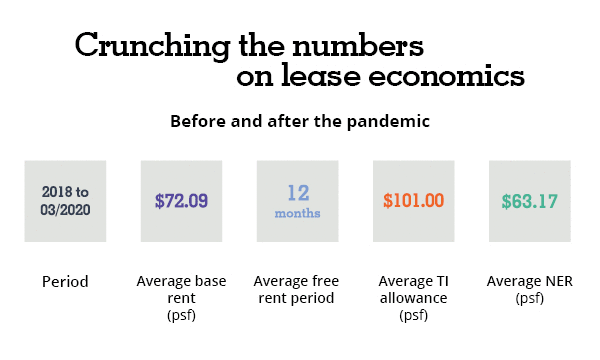The Data Bite: Early lessons from post-pandemic leasing economics


Widespread vaccinations, dramatic drops in positive tests and historic lows in death rates offer encouraging signs that most markets are recovering from the COVID-19 pandemic. But what will this mean for companies and their workers in this return to normalcy?
Unlike in past recessions, technological advancements and health concerns triggered a historic shift in how companies operate. For landlords anxiously waiting for consensus to emerge on a return to the office, there is real urgency. How are landlords enticing tenants to take their first steps back to the office and encouraging them to make commitments in the current environment?
What do net effective rents tell us?
Judging from average base rents, the market seems surprisingly unchanged, but that masks underlying factors that favor tenants. Using the Washington D.C. market as an example, base rents have remained static, decreasing by $0.10 (0.1%) compared to pre-lockdown prices. As a shrinking crop of tenants navigate the market with conviction, landlords are offering longer free rent periods and more generous tenant improvement allowances.
This has resulted in net effective rents—a metric that combines base rents and concessions—that are down 8.7% since the start of the pandemic.
As tenants continue to evaluate long-term office needs, landlords have offered attractive packages to retain or grow leased space. From 2018 to March of 2020 in the Washington D.C. market, the average free rent period was 12 months, which has jumped to an average of 20 months since that time. In that same period, tenant improvement allowances rose $6.00 to an average of $107 per square foot.
Market conditions at a crossroads
All this has put market conditions at a crossroads, as companies evaluate the effectiveness of continuing full or partial remote work strategies. In the short term, we may see more moderate concession packages as companies gain more clarity and require less enticing to sign new leases. Longer-term, as it becomes clear what proportion of tenants plan to abandon the office altogether, the supply-demand imbalance could continue to favor tenants.
The rest of 2021 will be when clarity emerges on long-term leasing economics. What portion of tenants will be permanently lost to the market? Will companies and their workers seek a return to the office to maintain productivity and culture? Regardless, we anticipate that base rents should begin to trend downward as supply outstrips demand, just as net effective rents have already dropped.
Note: Data represents Washington D.C. Class A, direct relocations only normalized for 10-year lease terms. Source: Avison Young
Snack-sized data and insights delivered weekly… and like any good snack, it’s both delightful and easy to digest. To get your fill delivered weekly in your inbox, sign up with our form.
